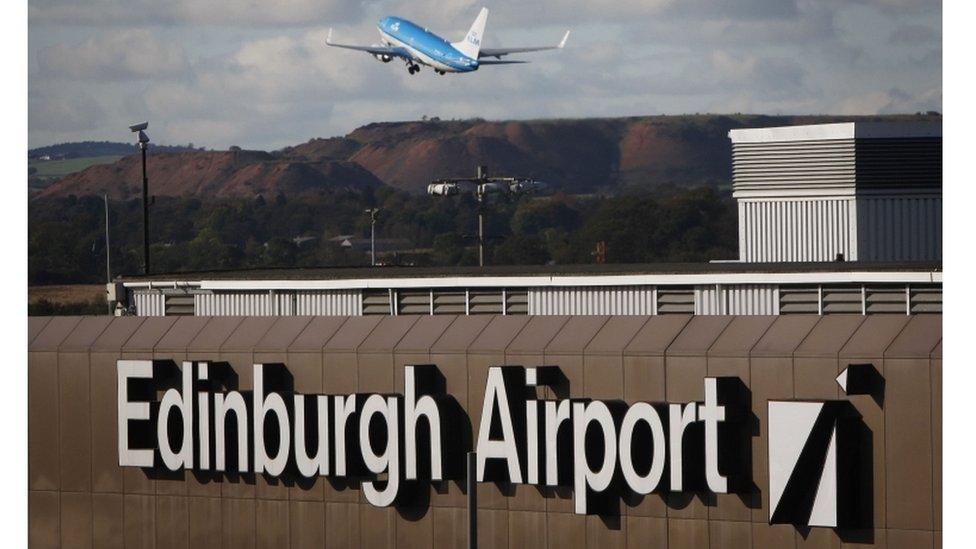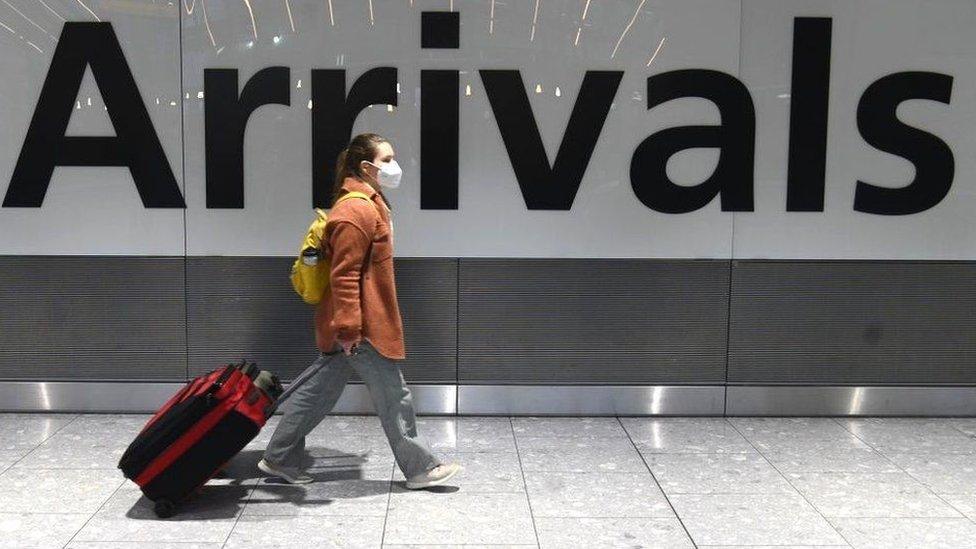When will Covid recovery take flight?
- Published

Inbound tourism is of vital importance across Scotland and not just at airports, with foreign tourists spending far more per day than staycationers.
A second year of colossal losses for airlines is raising concerns that the extent and shape of international travel may be permanently harmed.
Industry frustration is high at the lack of detail in Downing Street plans for re-starting foreign travel, and the lack of any plans in Scotland.
It may be a peculiarly British thing to do with the weather, but most political and media discussion of air travel follows a well-trodden flight path in assuming it's all about holidays and getting to the sun.
A balanced view would take into account that aircraft also take people out the country to work in support of their British employers, selling goods and services overseas.
And in the hold, they carry a lot of light, valuable exports, notably including fresh Scottish salmon.
For more balance still, it's worth remembering that aircraft bring people into the UK. And when they do, those people spend a lot more per head than domestic tourists.
VisitBritain estimates a 78% drop in international tourist visits to Scotland between 2019 and 2020, and an 85% drop in spend to £388m. That's more than £2bn of spending power suddenly sucked out the economy.
So the impact of grounded aviation is felt not only at airports or in travel agents, but in every business where inbound travellers spend their money.
That's why the continuing uncertainty about the return of international travel carries wider concerns than Britain's summer holidays.
In the rough
As my colleague, Steven Godden, reported for TV from St Andrews, the absence of foreign visitors puts golf tourism deep into the rough.
Visit Scotland calculates that a golfing tourist spends an average £245 per day. For an overseas golfing visitor, that is £338 daily, and from the US, it's £405.

There are concerns about the loss of golf tourists
That is in green fees, hotels, meals, drinks, transport and high-end gift shops. Many are located in small towns which have become dependent on the trade, from Turnberry in Ayrshire to Dornoch in Sutherland.
Steven heard also from a luxury coach operator who specialises in golf tourism. Gordon Donaldson of St Andrews Executive Travel estimates that his company would be around a third of its size without foreign visitors, employing six to eight people instead of 50-plus in the summer months.
He reported that firms are optimistic that visitors will be back before the end of this summer season. The aviation industry is less positive.
Burning through billions
Edinburgh Airport's chief executive Gordon Dewar sounds increasingly exasperated at the lack of a clear flight path back to the reopening of routes, and is warning they may not return. Last year saw a 76% drop in passenger numbers.
International flights have become rare. Last week, Scotland's capital airport operated only 18 routes, of which only nine were international, and these averaged just seven flights per day.
The equivalent week in 2019 saw 132 international routes, with a daily average of 173 air traffic movements.

Edinburgh Airport's Gordon Dewar has warned that some routes may not return
Qatar airline's links with Doha is the only remaining wide-bodied long-haul route, at quarter of its previous frequency. So there are no longer inbound flights from Istanbul, Dubai or North America. Norwegian airline has permanently given up trans-Atlantic flights, and others are scaling back their ambitions for growth.
Translated into the global picture, on Wednesday IATA, the airline industry body updated the staggering losses being incurred, warning that rising fuel costs and continued barriers to international travel will push carriers to bring back only profitable routes.
After totalled losses of $126bn last year, they expect losses this year to be $48bn. With fixed costs and loss-making routes, it is forecast that airlines will burn through $81bn of cash during 2021.
Large countries such as the USA, Canada, Russia and Australia have stronger domestic airline operations, but globally, international passenger numbers are down 87% on pre-pandemic levels. That affects Europe (including the UK) most, where only 11% of passenger miles are domestic, so demand is down 66% and capacity down 57%.
Midsummer boost
Even with agreement on testing regimes and the rollout of vaccines, passenger numbers are expected to rise globally to only around a third of pre-pandemic levels in the second half of this year. And vaccinations appear to be making little impact on rampant infection rates in some countries, with high uncertainty about new variants.
The UK story on vaccinations has given it a fortress mentality, with political leadership keen to protect the nations from inbound infections. That has meant that the route to reopening international travel is particularly fraught and uncertain.
Boris Johnson's talk of a return to normality by midsummer boosted outbound bookings at first, but since then, a reopening starting from mid-May looks less likely as infection rages in our main travel destinations.
The UK government plan has had a scathing response from the Commons transport committee today. MPs say it lacks sufficient detail in most areas, and where it does offer detail, it means very high costs for travellers. The tests required for a family of four travelling to destinations with low infection rates could cost more than the flights.
Traffic lights
The aviation industry can handle some uncertainty, but it is even more frustrated where the Scottish government offers no provisional dates for reopening any foreign travel.
First Minister Nicola Sturgeon cites health reasons for caution. She says the intention is to co-ordinate Scotland's approach with the other three UK nations. That probably means a traffic-light approach of red countries with high infection and green countries for direct links, with tests of some sort required.

But the industry is not clear. It needs several weeks to be able to put aircraft and crew in place for a restart, and wants even more to be able to sell tickets. Having got the signal earlier this year that Scotland would be slower to restart international travel than England, airlines warned they would move planes out of Scottish bases.
The industry perceives that its concerns are treated as a low priority. The aviation forum with the Scottish government, at which it tries to get its frustrations across, has met three times without much sign of progress, and its meetings are understood to have become increasingly fractious.
Hub and spokes
Over the past 20 years, Scotland's main airports successfully built direct links to numerous destinations including distant international hubs in the Middle East and North America, with hopes of expanding to Asia. This is more attractive for inbound and outbound travellers, avoiding longer journeys, usually at greater expense, through London, Schipol, Paris or Frankfurt.
Inbound travellers to London are notoriously reluctant even to change terminals at Heathrow, so many never get beyond London. That's why direct links are particularly important to inbound tourism in Scotland.
That business model has been broken by the pandemic. One big question is whether it can be repaired, or if Scotland's long-haul connections have been harmed in the long term.
Another is whether the strengthening emphasis on reducing climate changing emissions will mean that air travel never returns to the way it was.
